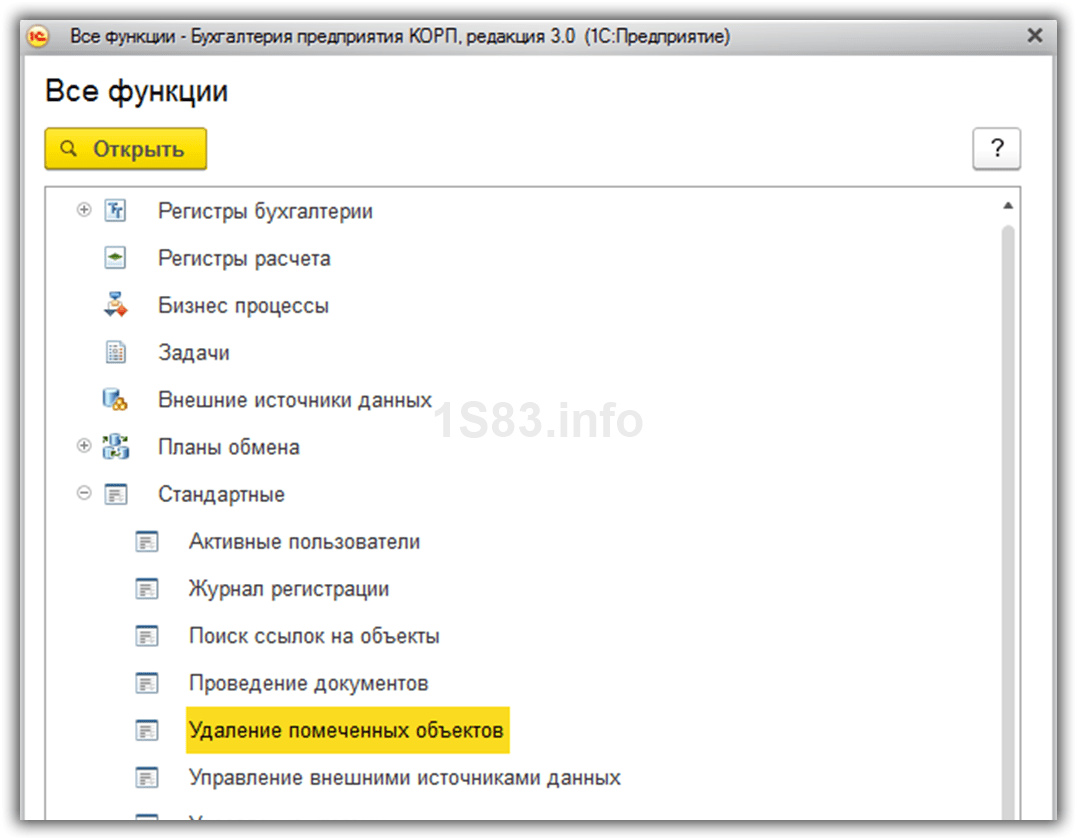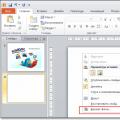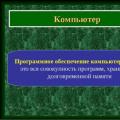Mark for deletion 1s. Automatic deletion of directories and documents
In the 1C program, almost no object can be physically deleted immediately. This feature is configured in roles (permissions "delete" and "interactive deletion"). Usually, the developer does not allow such actions to be performed in order to avoid disastrous consequences in the future.
Marking for deletion means that the object is irrelevant for the user. When you set a mark on a document, its posting is automatically cancelled.
An example of deleting a reference item Nomenclature
In our example, we will delete the element, but the process of deleting a document or any other object is no different from the above instructions.
Set the flag for deletion directly from the list form of this directory. To do this, select the position we need and press the Del key on the keyboard (or using the context menu).
The program will ask us a question about the need (or removal) of the mark for deletion. We will answer "Yes".

After that, a sign will appear at the directory element we have selected. We remind you that if a configuration object has the rights to delete or interactive delete, then using the Shift + Del combination you can immediately delete it physically.
Now we can proceed to the direct removal of our directory object. If you do not have this functionality available, then you do not have the appropriate rights to it.
Select "Delete Marked Objects" from the "Administration" menu.
Also, this functionality is available in the "All functions" menu.

In the window that opens, the program will prompt you to choose whether you want to delete all objects marked for deletion or only some. In our example, we will delete only the nomenclature "Edged board 50 * 250 * 300".


For some time the system will calculate whether other infobase objects refer to our board. As a result, the program gave us a notification that deletion was not possible.


In order for our nomenclature to be deleted after all, it is necessary to mark all objects in the table on the right for deletion. Another option is to replace our object with another everywhere.
You shouldn't have any problems flagging related objects for deletion, so we'll choose a replacement.
Click on the "Replace..." button.

Let's select the stock item that will be replaced in all related objects. After that, the window for re-deleting will again be available to you. This time everything went well, as the program notified us.
Scheduled automatic deletion of marked objects
In newer versions of the 1C program (starting from 8.3), the developers have added a very convenient ability to automatically delete marked objects on a schedule. Let's see how to make this setting.

In the form that opens, go to the Scheduled Operations section and check the box next to Automatically delete marked objects on a schedule. After that, the "Set up schedule" hyperlink will become active for you. Follow it.

You will see a standard form for setting the schedule. If necessary, you can change the default values, but so that the start time of this scheduled operation does not coincide with the working hours of your organization's employees.
Send this article to my mail
When trying to delete an unnecessary system object (directory element, document, report option, etc.), the user will not be able to permanently remove it from the 1C database, only setting the mark for deletion is available to him. Therefore, the question arises - How to delete marked objects in 1C 8.3?
In this article, we'll walk you through this process. The deletion functionality for many configurations is identical and the described technique is suitable for UT, ERP, Accounting and ZUP.
To completely remove an object from the 1C database, you must run the Delete marked objects processing. This was done not to complicate the work of users, but to avoid errors. For example, if you remove the counterparty for which the sale is registered, then the products will be sold to no one. Therefore, it is impossible to simply remove objects from the system, you must first make sure that it is not used anywhere and its absence will not lead to errors in the program, and it is for this purpose that the Delete marked objects processing is provided.
Thus, in 1C, deletion is performed in two stages:
Setting a mark for deletion in 1C;
Final removal by processing if the object is not involved in the system in any way.
How to set a mark for deletion in 1C 8.3?
To set a mark for deletion in 1C, select the desired directory / document (you can also select a list of objects at once), in the More menu, select the command Mark for deletion / Unmark (in some journals the icon for this command is displayed) or press the delete button on your keyboard . The system will ask you to confirm your intentions and after that a mark will be set.

Please note that if you try to checkmark an already marked element, the reverse action will be performed - unmarking.
How to delete marked objects?
In Accounting and ZUP, processing is available in the Administration section, in UT and ERP in the NSI and administration section → Support and maintenance. And if you suddenly forgot in which section to look for the desired system object, you can always use the All functions section.



Processing Deletion of marked objects is controlled by referential integrity, i.e. if there are references to the object being deleted in other objects, then the deletion procedure will not be performed.
There are two modes of operation with processing, automatic and manual (selective), and you can also set up a scheduled task to perform automatic deletion according to a specified schedule.
In selective mode, the system will display all items marked for deletion, grouped by type. The checkboxes are used to select objects that need to be permanently removed from the system. You can open an object by double-clicking the mouse. After the selection is made, click Delete and the process of clearing the database from marked objects will start.
In automatic mode, this process will start immediately.
As a result, regardless of the selected mode, processing will attempt to delete all objects with a mark. If deletion is not possible, a list of non-deleted objects with links to their places of use will be displayed.
The options available in this case are:

Mark for deletion and places of use and try deletion again.
Make corrections to places of use. For example, if you want to delete an employee that is in the Recruitment list document, you need to delete him from this document.
Perform the replacement procedure on the Replace command. A list of similar replacement items will be offered. For example, if you need to replace a characteristic of an item in a document, then a list of characteristics of the same item will be offered.

To automatically execute the procedure using a scheduled task, set the Automatically delete marked objects according to schedule flag in processing and configure the schedule.
Each accountant is regularly faced with the need to remove erroneously entered documents, directory data and accounting records from accounting. Deleting marked objects in 1C 8.3 is possible if their data is not used in another document. Next, we will talk about how to delete marked documents in 1C 8.3 in five steps.
Read in the article:
If you want to exclude, for example, an invoice from accounting, make sure that its data is not included in the reconciliation act. The same rule applies to any other documents and directories. For example, if you want to exclude a product from the "Nomenclature" directory, then make sure that this product is not used elsewhere, for example, in an invoice. Removal in 1C 8.3 is carried out in five steps.
First, we note that deleting marked objects in 1C 8.3 takes place in two stages:
- You need to mark the document or operation that you plan to delete
- Remove all marked objects
Step 1. Mark an object for deletion
Click on the document you want to exclude from accounting. It will be marked in yellow. Press the right mouse button, and in the window that opens, select the "Mark for deletion" command. Next, move on to the second step.
Step 2. Open the "Delete Marked Objects" window
Go to the "Administration" section (1) and click on the "Delete marked objects" link (2).

Step 3. Choose a mode
Deleting marked objects in 1C 8.3 can be carried out in two modes:
- automatic deletion of all marked objects;
- selective deletion of objects.
In automatic mode, the program will process all marked objects and delete those that are not associated with other documents. Selective deletion will remove objects of your choice from the list. The list will be generated by the program.
For automatic deletion, select "Automatic deletion of all marked objects" (3) and click on the "Delete" button (4). All objects marked for deletion will be excluded, but on the condition that their data is not used by the program in other places:

For selective deletion, select "Selective deletion of objects" (5) and click the "Next" button (6):

Step 4. Select objects to delete
If you use the selective deletion mode, then after clicking the "Next" button (6), a list of all documents that you have marked for deletion will open, it looks like this:

Check the boxes (7) for everything you want to delete. After that, click the "Delete" button (8):

If some documents are not deleted, continue to the next step.
Step 5. What to do if not all documents are deleted
The object cannot be deleted if the data from it is used by the program somewhere else. In this case, the program will show a list of non-deleted objects. For example, if you try to delete property (9) that is on the receipt (10), you will see the following window:

In the left half of the window you see a list of non-deleted objects (9), on the right a list of documents that contain their data (10). They are the ones that prevent the object from being excluded from the program, so they also need to be marked for deletion. In our case, to remove the nomenclature "Battery ..." (9), it is necessary to mark the invoice for deletion "Receipt 3 dated 06/25/2018." (10) and then repeat the procedure starting from step 2.
After you have made changes to your accounting, check any reports that may have been affected by them. If, as a result, accounting or tax accounting data has changed, it may be necessary to provide the tax inspectorate with updated declarations or calculations. If the adjustment in accounting has led to an increase in the amount of taxes payable to the budget, then first pay the difference in taxes and penalties, and then submit the revised declarations.
The 1C Enterprise system initially does not imply the direct removal of any objects from the database, for example, elements of directories, documents, reports, etc. Of course, you can still configure the user role so that he immediately removed from 1s some object, not flagged for deletion, but this is highly discouraged. We also want to note the fact that even if the user's role is configured for direct deletion of objects (interactive deletion), it is still will not allow him to delete some objects in the enterprise 1s, and this can only be done through mark for deletion.
Why was the mark made for deleting objects in 1s
Let's answer with you the question "Why was this mark made for deletion?", because it's faster remove object from 1s straightaway. This was done for several reasons:
- There is a possibility that the user later changes his mind and wants to return the deleted object, when it is enough to unmark it, interactive deletion cannot recover data.
- In 1s, one object, for example a document, can refer to many other objects in the system (directories, constants, other documents, etc.), and at the same time, many other objects can also refer to this object (in our case, a document). If in the 1s system the enterprise were allowed to directly delete objects from the database, then this would lead to terrible consequences, since objects with "broken links" would immediately begin to appear, and this is data loss, and not the correct functioning of the database, which sooner or later it will lead to the collapse of the database and the almost complete loss of your data!
Two types of deletion in 1s, the concept of referential integrity control in 1s
In a programme 1s objects can be deleted two ways:
- Using interactive deletion (direct deletion without referential integrity)
- Via mark for deletion (deletion with referential integrity control)
Let's look at what referential integrity is in 1s. But in order for us to answer this question, we must know what "broken" links in 1s are. For those who do not know, broken links in 1s are links that point to an unused memory area, that is, they essentially point to nowhere. Now let's take for example any document in the 1s enterprise system. It contains a variety of props. These attributes can be either simple (primitive types such as number, date, boolean), or they can be object (such as links to other system objects, for example, various directories, enumerations, etc.) So here is the control of referential integrity in 1s just means the fact that the object will not be deleted from the 1s system as long as any other objects of the system refer to it. Just marking the deletion of objects 1s allows you to save the referential integrity mechanism in 1s, since processing the deletion of marked objects will not allow you to delete the object while other objects refer to it.
How to recover deleted objects in 1s? What happens to objects after they are deleted from 1s?
Many people ask us similar questions, and there is only one answer, the physical deletion of data from 1s (using the methods described below) leads to the COMPLETE DESTRUCTION OF THE FILE FROM THE BASE! Restoring deleted files from the database is not possible.
We are always ready to provide you with timely assistance in updating the 1C 8.3 system.
Interactive removal in 1s
So we have already discussed with you that interactive deletion in 1s occurs without referential integrity control, and this is fraught with very bad consequences for the system, it is recommended to use such deletion only for debugging purposes. To turn on interactive removal 1s we first need to go to the configurator, open the branch General ---> Roles and select the "Full rights" role.

Now press the F9 key, we copy the "FullPermissions" role and another "FullPermissions1" will appear. Open it with a double click. The role properties window will appear, click the "Actions" ---> "Set all rights" button. After that, click OK. Now let's save the database configuration, to do this, click on the little blue barrel in the upper left corner, or press the F7 key. If the keg has become inactive, then the configuration has been saved. We have created a role with rights to interactive removal of objects from 1s .

Now in the configurator, open the tab Administration ---> Users.

A list of users will open, select the user under which you want to enable interactive deletion of 1c objects and press the pencil or F2. The user properties window will open, go to the second tab "Other". There, find the role that we copied with you, in my case it is "FullPermissions1", check the box and click OK.

After that, run 1c enterprise, select the user who has the new role installed. Now you can delete objects directly, to delete an object, select it and press the SHIFT + DEL key combination, the system will ask if you are sure about deleting, if yes, the object will be deleted from the system.
Deleting objects 1s through a mark for deletion or how to delete objects in 1s?
Now let's take a look at the question How to delete objects in 1s?". So, we open the database we need in 1s enterprise. The screenshot shows the "Accounting Department of a state institution", click on the "Operations" tab in the menu ---> " Deleting marked objects".

If you have a managed interface, such as in "Enterprise Accounting Rev. 3.0", then there you need to go to the "Administration" tab, there you will see the "Service" subgroup, and already in it you need to select " Deleting marked objects".

An alternative way to open the object deletion assistant in 1C 8.2 and 1C 8.3
In general, if you cannot find a button in your configuration with which you can call the wizard deleting marked objects 1s, then in 1C 8.2 you can open it in the following way, this method is suitable for any configuration, the screenshots below show what actions need to be performed in 1C 8.2. Open the tree of all processings that are in the system and select " Deleting marked objects".


If you are working on the 1C 8.3 platform and you have a configuration with a managed interface, then you need to enable the "All functions" button, see how to do this.
Start searching for objects marked for deletion in 1s
A window will appear in front of us which is shown below, it will reflect all objects marked for deletion in the system. We tick off those that we want to delete, in general it is desirable to delete them all, because they are marked for deletion, which means they are no longer needed in the system. After you have marked everything you need, click "Control".

It will take some time for the system to complete this task, a little later you will see the window shown below. Please note that you can have objects with both green checkmarks and red ones.

Green means that the object can be deleted, red means that it is not. An object marked with a red check mark cannot be deleted, since other objects of the system refer to it, in the window below you will see those objects that refer to it, and before deleting an object marked with a red check mark, you need to remove references to this object from other objects. What does this mean in practice?
The need for timely deletion of objects marked for deletion in 1s. How to delete objects marked with red ticks?
Let's consider an example using the "Enterprise Accounting" configuration. We have a document "Acceptance for OS accounting", it accordingly indicates the main asset (for example, a computer) and many other parameters, but they are not of interest to us at the moment. If we want to remove this OS from our database, then nothing will come of it without additional actions. Our OS (computer) will be marked with a red checkmark when you try to delete it. Why? But our document "Acceptance for OS accounting" has a link to the OS that we now want to delete! When we click on it in the list of objects, we will see all the objects that refer to our OS, and before deleting this OS, we need to first go into all these objects and remove the links. In our case, this means that you need to cancel the posting of the document "Acceptance for accounting of fixed assets", and delete this fixed asset from the document, and then record the document. Now the document no longer refers to our OS, and we can delete it. From all this follows one rule, you need to delete objects marked for deletion in 1s in a timely manner! Otherwise, getting rid of them later can be very, very problematic, due to the fact that there will be a large number of links between objects. By the way, timely deleting objects from 1s also has several obvious advantages:
- Increases system performance
- Reduced chance of user errors
- Reducing the size of your database
- There is no "cluttered interface" when the system has a lot of objects marked for deletion, posted documents, and also not posted.
In our company you will always receive first-class service of the 1C program at very reasonable prices!
Completion of deletion of marked objects in 1s
Now let's remove the objects to the end. Click the "Delete" button. The system will delete all objects that have been marked with green checkmarks.

Only those that are marked with red checkmarks will remain, click "Close", this is the process deleting objects from 1s completed. If something didn’t work out for you, we are ready to connect to your 1s remotely and help solve your problems.

1s removal of marked objects, detailed video instruction on deleting objects 1s
- We tell you why you need a mark for deletion in 1s
- We show by example how to delete objects in 1s
- Useful practical advice given
- We show how to delete objects marked with red checkmarks in 1s
- It also provides a lot of other useful information.
We hope that our article is about deletion in 1s of objects marked for deletion Helped you a lot and answered all your questions.
 How to set a background for a PowerPoint presentation?
How to set a background for a PowerPoint presentation? Presentation on the topic "system software" Application packages
Presentation on the topic "system software" Application packages Telephone network The telephone network is the most common type of operational communication.
Telephone network The telephone network is the most common type of operational communication.